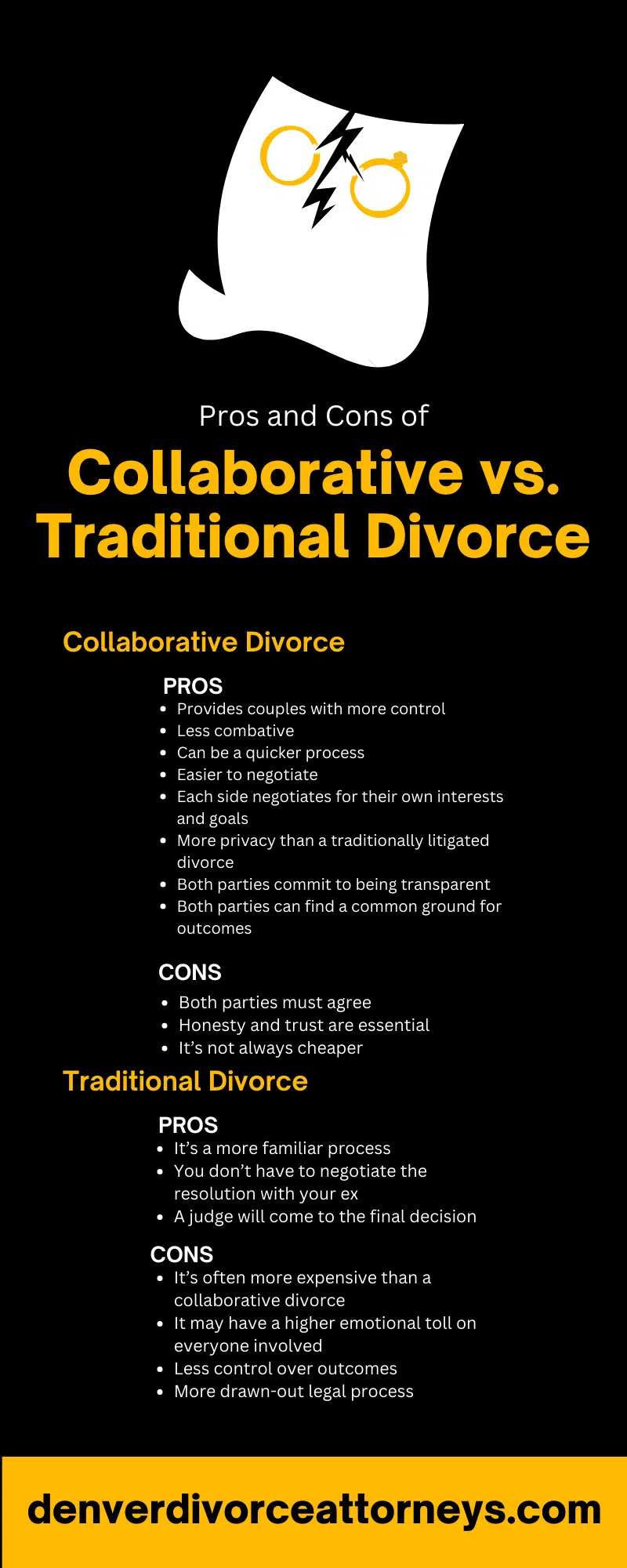A marriage can end for a variety of reasons, and when this happens, the couple needs to decide on a divorce route. Many people assume that this always requires going to court, but this route may not apply to all types of divorce. Learn the pros and cons of collaborative versus traditional divorce to decide which one to pursue.
What Is a Collaborative Divorce?
A collaborative divorce is when both parties openly communicate with one another and their attorneys to end the marriage and reach a conclusion they agree on. During a collaborative divorce, both parties agree to make legal decisions without going to court; their lawyers assist with the legal process.
Sometimes, couples involve additional professionals such as financial advisers to assist with the division of assets. A couple may also involve a child specialist to determine the ideal coparenting plan based on the child’s wants and needs. Each expert brings specific insight that further aids the process.
The Pros and Cons of a Collaborative Divorce
Since collaborative divorce requires more cooperation, it’s usually less stressful than litigation. However, this option doesn’t work for all couples, since it requires willing collaboration. If one party contests the divorce or is not committed to a peaceful resolution, this option may not work.
We’ve listed some pros and cons to help couples determine if collaborative divorce is the ideal option for their cases.
The Pros of a Collaborative Divorce
A collaborative divorce offers numerous benefits, including:
- Provides couples with more control;
- Less combative;
- Can be a quicker process;
- Each side negotiates for their own interests and goals;More privacy than a traditionally litigated divorce;
- Both parties commit to being transparent; and
- Both parties can find a common ground for outcomes.
Many of the pros of collaborative divorce lead to other benefits. For instance, since cooperation may speed up the divorce process, you may have lower legal fees. Moreover, keeping the process agreeable and less stressful makes it easier for couples with kids to focus on what’s important and to keep their children out of the court system. Watching their parents get divorced can be stressful for a child, and protecting them from hostile disputes is optimal for their well-being. Collaborating with your soon-to-be ex and a family law custody attorney will allow you two to decide what’s best for your child.
The Cons of Collaborative Divorce
Although collaborative divorce may sound like an ideal option, it’s important to note the cons, such as:
- Both parties must agree;
- Honesty and trust are essential; and
- It’s not always cheaper.
For example, if you don’t trust your spouse to be forthcoming with information or you have a dynamic that prevents you from collaborating in a cohesive way, collaborative divorce may not be the appropriate path for you. Still, you may be able to overcome each of these disadvantages. Hiring additional professionals such as child specialists and financial advisers costs money, but you two can split the fees to reduce individual costs.
What Is Traditional Divorce?
In a traditional or litigated divorce, each party can hire an attorney and bring their case before a judge. Often, parties must involve the courts in traditional divorce because one or both parties are behaving in a hostile manner or cannot reach mutual agreements. Due to this, a traditional divorce is often more drawn out and emotional than a collaborative divorce.
The Pros and Cons of a Traditional Divorce
Although traditional divorce may not seem ideal, what you consider “ideal” depends on the situation. If one party is highly argumentative, attempting a collaborative divorce may create additional stress and add unnecessary steps to the process. Weighing the pros and cons of traditional divorce can help you decide if it’s the right route for your split.
The Pros of Traditional Divorce
Some of the most common reasons couples choose traditional divorce include:
- It’s a more familiar process;
- You don’t have to negotiate the resolution with your ex; and
- A judge will come to the final decision.
These pros are the most beneficial for individuals in toxic relationships or who are divorcing due to infidelity or unwillingness to communicate.
The Cons of Traditional Divorce
It’s also important to remain aware of the disadvantages of a traditional divorce. Some cons include the following:
- It’s often more expensive than a collaborative divorce;
- It may have a higher emotional toll on everyone involved;
- Less control over outcomes; and
- More drawn-out legal process.
Similar to a collaborative divorce, the cons of a traditional divorce interrelate. Since traditional litigation tends to become more emotional and stressful, the divorce can be harder to conclude; this is especially true for aspects such as the division of assets and coparenting plans.
Picking the Best Option for Your Situation
The first step in this process is noting the pros and cons of collaborative versus traditional divorce. Next, you need to analyze your situation and the details of your case to know what will work best for you and your soon-to-be ex.
Consider Your Relationship
Before proceeding, carefully and honestly consider your current relationship with your partner. Are all your conversations arguments, or can you openly communicate? If you don’t feel comfortable communicating with your ex directly, a traditional divorce may be the better option.
On the other hand, divorce doesn’t have to mean volatile arguments. Although many people assume that most divorces occur after trust-shattering events, couples split up for various reasons—not all of them nefarious. In these instances, both parties may still value a friendship or cordial relationship. Couples in this category are more inclined to cooperate for a collaborative divorce.
Put the Kids First
Understandably, you’ll feel a lot of complex emotions throughout your divorce; this is a natural aspect of grieving the end of a relationship. However, hearing their parents argue or witnessing a drawn-out divorce can upset a child. The more willing you and your soon-to-be ex are to cooperate, the easier it is to shield your child from fallout.
If you have children, always choose the safest option. Do not attempt a collaborative divorce if it means putting yourself in physical or emotional danger. Putting the kids first means doing what’s best for them; a dangerous environment is never ideal.
Work With an Attorney
Contacting a knowledgeable family law attorney early on in your divorce proceedings is always best. You can discuss the details of your case and get essential legal advice. A lawyer will review the details with you and determine whether collaborative or traditional divorce is the better route. An attorney can also assist in creating a coparenting plan, dividing assets, and determining the need for alimony or child support. Additionally, a lawyer will advocate for your rights and keep your best interests at the forefront.
Jones Law Firm, PC has in-depth knowledge of Colorado divorce and child custody laws. Our team of legal professionals can guide you through your divorce in the way that works best for your case. Schedule a consultation with our team to begin working with one of our family law attorneys.


